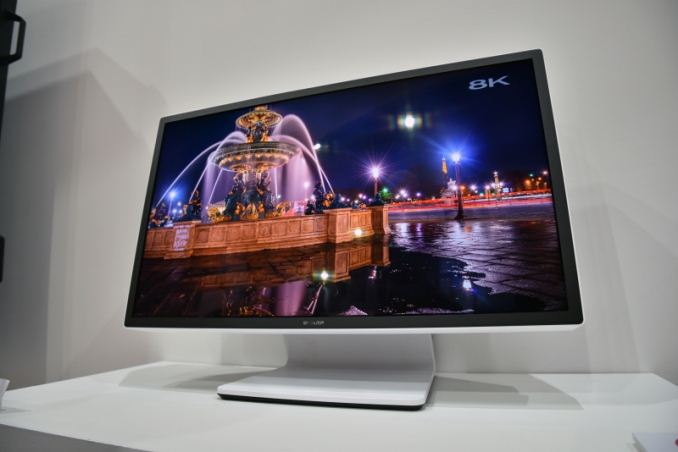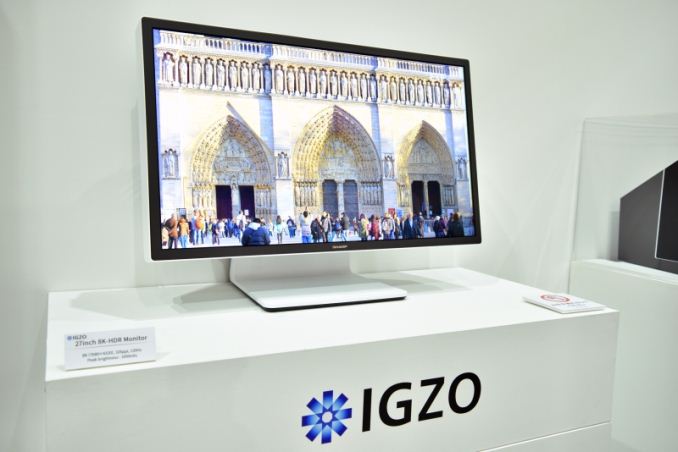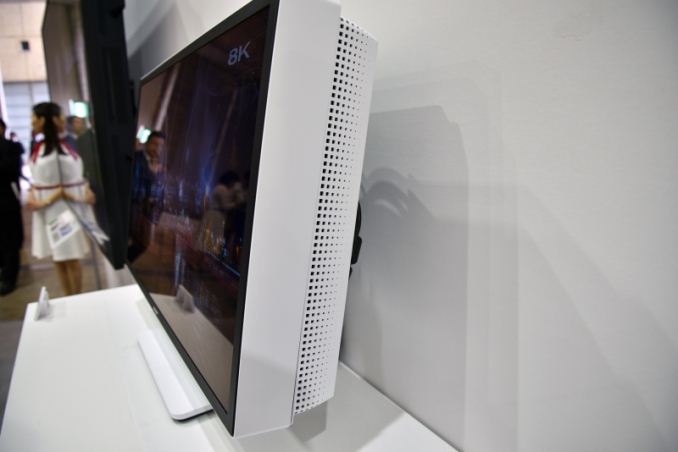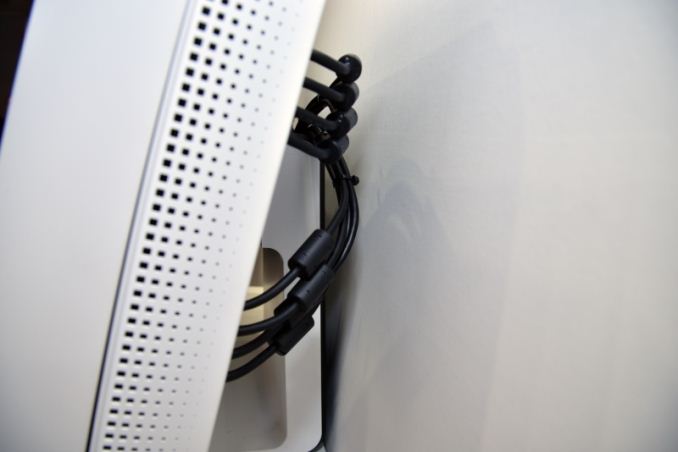CEATEC 2016: Sharp Showcases 27-inch 8K 120Hz IGZO Monitor with HDR, also 1000 PPI for VR
by Ian Cutress on October 5, 2016 10:15 AM EST- Posted in
- Monitors
- 120Hz
- DisplayPort
- Trade Shows
- Sharp
- IGZO
- 8K
- HDR
- CEATIC

While we’re not CEATEC, a Japanese technology show, news has come via PC Watch regarding a new publicly announced milestone in monitor production. For any journalist that has attended either IFA, Computex, CES or MWC over the past year, it would be hard going to miss one of the super large (80-inch plus) 8K monitors doing the rounds. While highly impressive in their own right, current 8K displays on show typically have a low pixel-per-inch value in order to achieve a good panel off the production line. So despite the fact we can get 4K panels on smartphones (Sony Xperia Z5 Premium is 4K in 5.5-inch, or 806 PPI), expanding the size at that pixel density is difficult with panel yields. Also, moving 8K down to a 'monitor size' has been hidden at the panel companies internal research divisions until now.
So this is where the Sharp monitor on display at CEATEC gets interesting. The IGZO display is down at 27-inches, marking a 326 PPI, just hitting at the door of large FHD smartphone displays. The panel is also listed at 1000 nit brightness. But to double down on specifications, the stand listed the display as supporting 120 Hz while in 8K mode, and also supporting High Dynamic Range, or HDR. This requires a large amount of data to be pumped into the display, and as a result a photograph of the rear shows eight separate DisplayPort cables being used in order to give the display the data it needs. 8K120 with HDR is no easy task, suggesting 7680x4320 at 10 bits per color channel (so 30-bit for RGB) at 120 times a second would suggest needing 120 gigabits per second of bandwidth at a minimum (or 15 GB/sec). That's even before you discuss overhead, which will push that higher.
Needless to say, this is a prototype panel. Businesses with large enough checkbooks are free to try and estimate a figure for such a display, because it will be a while before a device of these specifications hits commercial availability.
Also in the display was a 2.87-inch display, offering 1920x2160 resolution and rolling in at over 1000 pixels per inch (1008 PPI). This was described as ‘4K to both eyes’, affording a combined display suitable for head-mounted units or virtual reality headsets. Compare this to the HTC Vive, which uses a 1200x1080 screen per eye at 3.62 inches per panel, making it 447 PPI. This gives the Sharp panel a specification of over double the amount of pixels in a given area. Of course, with that comes cost and the ability to feed that display with enough data either over cable or other means. Still, it’s an interesting prospect.
Source: PC Watch














44 Comments
View All Comments
Mr Perfect - Wednesday, October 5, 2016 - link
That's a very specific frequency. What is it for?Communism - Wednesday, October 5, 2016 - link
Sorry, fumbled an entry, that should say 215.784 hz.That's 23.976 x 9
Communism - Wednesday, October 5, 2016 - link
It's just the highest multiple of 23.976 that fits in the bandwidth requirement of DP 1.3/1.4 without trickery when using 2560 x 1440 x 30 bit per pixel (10 bit per color)sonicmerlin - Saturday, December 3, 2016 - link
Why do you need adaptive sync if you have such a high frame rate?edzieba - Wednesday, October 5, 2016 - link
A bit odd to sell an LCD display based on it's VR credentials: even with ULMB, LCD takes a severe latency hit due to needing to wait for all pixels to switch and stabilise before you can pulse the backlight (or else you will be illuminating pixels with the wrong values), which also caps the maximum refresh rate.Taracta - Wednesday, October 5, 2016 - link
Is it CEATIC or CEATEC?djayjp - Wednesday, October 5, 2016 - link
How is that VR display any different than the Sony phone one?iophobia - Thursday, October 6, 2016 - link
Given that IGZO is just a faster replacement for the silicon transistor, I wonder what display technology these displays use. From the contrast I would assume OLED which would benefit from the faster IGZO. However, the problem you're facing then is the awful Pentile Matrix that still plagues OLED beside all its merits.Chaotic42 - Thursday, October 6, 2016 - link
8K? 120Hz? A reasonable size? Shut up and take my money!zodiacfml - Friday, October 7, 2016 - link
Awesome, though we have yet to see the latest display interfaces on monitors.